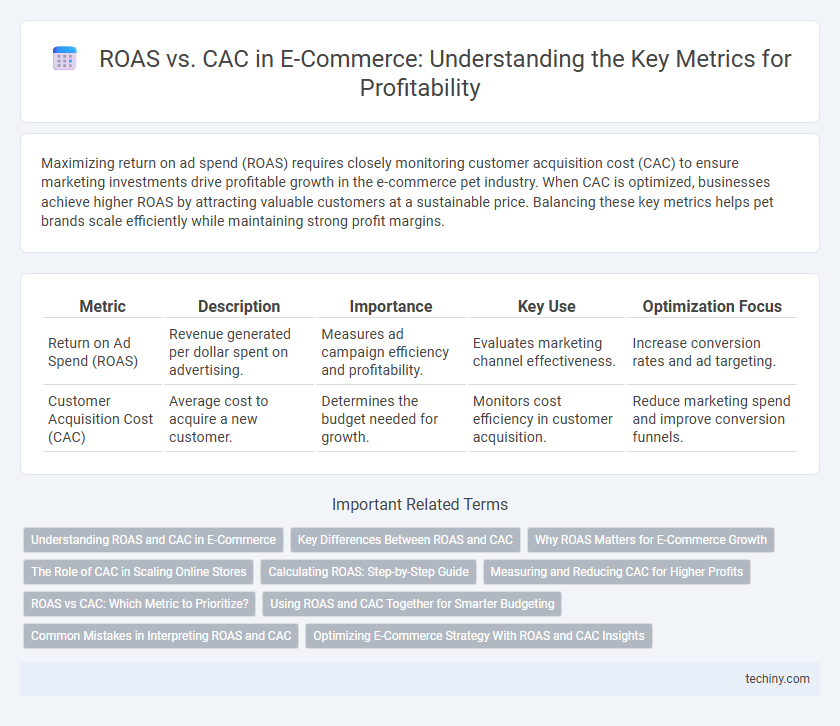Maximizing return on ad spend (ROAS) requires closely monitoring customer acquisition cost (CAC) to ensure marketing investments drive profitable growth in the e-commerce pet industry. When CAC is optimized, businesses achieve higher ROAS by attracting valuable customers at a sustainable price. Balancing these key metrics helps pet brands scale efficiently while maintaining strong profit margins.
Table of Comparison
| Metric | Description | Importance | Key Use | Optimization Focus |
|---|---|---|---|---|
| Return on Ad Spend (ROAS) | Revenue generated per dollar spent on advertising. | Measures ad campaign efficiency and profitability. | Evaluates marketing channel effectiveness. | Increase conversion rates and ad targeting. |
| Customer Acquisition Cost (CAC) | Average cost to acquire a new customer. | Determines the budget needed for growth. | Monitors cost efficiency in customer acquisition. | Reduce marketing spend and improve conversion funnels. |
Understanding ROAS and CAC in E-Commerce
Return on ad spend (ROAS) measures the revenue generated for every dollar spent on advertising, serving as a key indicator of campaign profitability in e-commerce. Customer acquisition cost (CAC) calculates the total marketing expenses divided by the number of new customers acquired, reflecting the efficiency of customer acquisition strategies. Analyzing both ROAS and CAC helps e-commerce businesses optimize marketing budgets, balance revenue growth with acquisition efficiency, and improve overall return on investment.
Key Differences Between ROAS and CAC
Return on Ad Spend (ROAS) measures the revenue generated from each dollar spent on advertising, emphasizing the efficiency of marketing campaigns, while Customer Acquisition Cost (CAC) calculates the total cost to acquire a new customer, focusing on overall sales and marketing expenses. ROAS is directly linked to the immediate financial return from ads, whereas CAC includes broader costs like sales team salaries, promotions, and onboarding expenses. Understanding these key differences helps e-commerce businesses optimize marketing budgets by balancing short-term ad performance and long-term customer value.
Why ROAS Matters for E-Commerce Growth
ROAS directly measures the revenue generated per dollar spent on advertising, providing clear insight into the effectiveness of marketing campaigns in driving sales. E-commerce businesses that optimize ROAS can increase profitability by identifying high-performing channels and reducing wasted ad spend. Lower CAC combined with higher ROAS results in sustainable growth and improved customer lifetime value, reinforcing the importance of ROAS in strategic decision-making.
The Role of CAC in Scaling Online Stores
Customer Acquisition Cost (CAC) directly impacts the scalability of online stores by determining the investment required to attract each new customer. Efficient management of CAC enables e-commerce businesses to optimize marketing budgets and maintain profitability while expanding their customer base. Balancing CAC with Return on Ad Spend (ROAS) ensures sustainable growth and maximizes revenue from advertising efforts.
Calculating ROAS: Step-by-Step Guide
Calculating Return on Ad Spend (ROAS) involves dividing the total revenue generated from ads by the amount spent on advertising, expressed as ROAS = Revenue from Ads / Advertising Cost. For e-commerce businesses, tracking accurate revenue attribution to specific campaigns or channels ensures precise ROAS measurement. Regularly analyzing ROAS alongside Customer Acquisition Cost (CAC) provides insights into advertising efficiency and profitability, helping optimize marketing budget allocation.
Measuring and Reducing CAC for Higher Profits
Measuring Customer Acquisition Cost (CAC) precisely involves tracking total marketing expenses against the number of new customers acquired, providing a clear metric to evaluate campaign efficiency. Reducing CAC can be achieved through targeted advertising, optimizing ad spend by focusing on high-converting channels, and improving conversion rates via personalized user experiences. Balancing CAC below Return on Ad Spend (ROAS) ensures sustainable profitability, enabling e-commerce businesses to maximize lifetime customer value and drive higher returns.
ROAS vs CAC: Which Metric to Prioritize?
Return on ad spend (ROAS) measures the revenue generated per dollar spent on advertising, while customer acquisition cost (CAC) calculates the total marketing cost to acquire a new customer. Prioritizing ROAS emphasizes immediate revenue efficiency, making it ideal for campaigns focused on sales and profitability. In contrast, focusing on CAC supports long-term growth by optimizing marketing spend to acquire valuable customers at sustainable costs.
Using ROAS and CAC Together for Smarter Budgeting
Maximizing e-commerce profitability requires balancing Return on Ad Spend (ROAS) with Customer Acquisition Cost (CAC) for smarter budgeting decisions. Analyzing ROAS helps measure the revenue generated per advertising dollar, while CAC tracks the total investment required to acquire a customer, revealing cost-efficiency in marketing strategies. Integrating ROAS and CAC data allows businesses to optimize ad spend, allocate budgets effectively, and improve overall customer lifetime value.
Common Mistakes in Interpreting ROAS and CAC
Misinterpreting Return on Ad Spend (ROAS) by neglecting Customer Acquisition Cost (CAC) leads to skewed profitability analysis in e-commerce. Focusing solely on ROAS without factoring in CAC can mask high marketing expenses that reduce net margins. Accurate evaluation requires integrating both metrics to ensure marketing campaigns drive sustainable growth and positive return on investment.
Optimizing E-Commerce Strategy With ROAS and CAC Insights
Analyzing Return on Ad Spend (ROAS) alongside Customer Acquisition Cost (CAC) provides critical insights for optimizing e-commerce strategies, enabling precise allocation of marketing budgets to channels with the highest profitability. By reducing CAC while maintaining or increasing ROAS, businesses enhance revenue growth and improve overall marketing efficiency. Tracking these metrics regularly allows for data-driven decisions that drive targeted customer acquisition and sustainable scalability.
return on ad spend (ROAS) vs customer acquisition cost (CAC) Infographic

 techiny.com
techiny.com